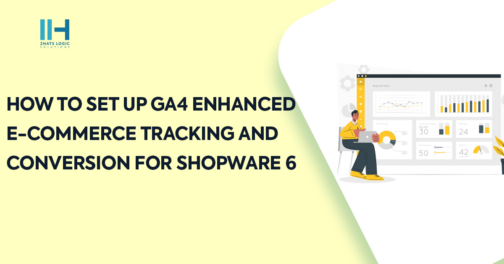Greetings! I'm Aneesh Sreedharan, CEO of 2Hats Logic Solutions. At 2Hats Logic Solutions, we are dedicated to providing technical expertise and resolving your concerns in the world of technology. Our blog page serves as a resource where we share insights and experiences, offering valuable perspectives on your queries.

As an ecommerce store owner, tracking customer behaviour is crucial. Analytics help us gather accurate insights. E-commerce tracking provides a comprehensive view of performance. The website analytics field is changing significantly, moving from Universal Analytics to Google Analytics 4 due to its discontinuation. Google Analytics 4 is a web analytics tool providing comprehensive insights into user behavior, engagement, and conversion metrics for both websites and apps. GA4 tracks more than just basic website visits. It also tracks granular user interactions, such as product views, add-to-carts, and checkout behaviour, to form a thorough tapestry of customer journey data. By doing so, you can identify exactly when customers may be dropping off during the buying process and make your store more “conversion-friendly.” In a multi-device world, customers seamlessly navigate between desktop computers, phones, and tablets. GA4 merges this data, providing you with a more comprehensive sense of user behaviour across devices. This allows you to grasp how customers interact with your brand from every possible angle. Google Analytics 4 is built with significant importance for user privacy. With certain features like cookiless measurements, and data collection of users to ensure your analytics practices remain compliant. With the support of machine learning, GA4 provides efficient predictive information. This is useful to forecast trends, understand the customer needs and even help to predict purchase. GA4 automates data analysis tasks. It identifies key trends and generates insightful reports. This will allow you to focus on what matters the most and save your valuable time and resources. To use Google Analytics, sign up for a new account if you don’t have one yet. If you have one sign in with your Google account. Then on the bottom left corner click the gear icon and select ‘Admin’. Then you have to click on ‘+Create Account’ and enter a name for your account. Then configure data sharing settings according to your preferences and click ‘Next’. To add a new property for your website click on ‘Create Property’ The next process is to set up a GA4 property. You have to choose ‘Web’ as the platform for your GA4 property. Then enter a name for your website and configure settings like reporting zone and currency. Then click on ‘Next’ and review the data sharing settings. Accept the terms of service and click “Create”. There are two ways to send data to your GA4 property. Start by signing up for a Google Tag Manager (GTM) account. GTM allows you to manage various tags and tracking codes on your website without directly modifying the site’s code. Once you have your GTM account, the next step is to create a container for your website. Think of a container as a virtual space where you’ll manage all your tracking codes and tags for a specific website. Within your GTM container, you’ll create a new tag. Tags are snippets of code that track specific actions or events on your website. In this case, we’re setting up Google Analytics 4 (GA4) tracking. When creating a new tag, select “Google Analytics: GA4 Configuration” as the tag type. This tells GTM that you want to integrate GA4 with your website. Your GA4 Measurement ID can be found in your GA4 property settings within your Google Analytics account. Copy this ID and paste it into the appropriate field in GTM. Ensure that the option to “Send a page view event when this configuration loads” is checked. This setting tells GA4 to track page views whenever this tag loads on your website. A trigger determines when and where your tag will fire. For tracking all website visits, set the trigger to “All Pages.” This means the tag will fire and track data on every page of your website. After configuring your tag and trigger, save the tag within GTM. Once you’re satisfied with your setup, publish your GTM container to make the changes live on your website. Begin by logging into your Google Analytics 4 (GA4) account. Once logged in, navigate to your GA4 property settings. In the GA4 property settings, locate the “Data Streams” section and select “Web” as the type of data stream you want to add. When adding a new stream, opt for “Manual measurement” instead of the automatic setup. This allows for more control and customization in tracking. Give your data stream a descriptive name that helps you identify it later, especially if you have multiple data streams for different purposes or websites. Provide the URL of the website you want to track using this data stream. Make sure to enter the complete and accurate URL to ensure proper tracking. The Measurement Protocol Secret adds an extra layer of security to your data stream. Click on “Generate” to create a unique secret code for your data stream. After generating the Measurement Protocol Secret, you’ll receive a global site tag (gtag.js). This is a JavaScript snippet that needs to be added to your website’s code. Copy the global site tag code provided and paste it immediately after the opening <head> tag on all pages of your website. This ensures that the tracking code is loaded and executed correctly for every visitor to your site. Setting up GA4 Enhanced E-commerce tracking on your Shopware 6 store is essential for deep customer insights, cross-device tracking, privacy compliance, and predictive analytics. Whether implemented via Google Tag Manager or manually for greater control, GA4 helps refine user journeys and marketing strategies, boosting conversions. Partner with a Shopware agency for easy integration.
Benefits of Google Analytics 4
In-depth Customer Insights
Cross-Device Tracking
Privacy-Focused Measurement
Predictive Analytics
Automated Analysis
Steps to Set up Google Analytics 4 in Shopware
Step 1: Create a Google Analytics Account
Step 2: Set Up a GA4 Property
Step 3: Choose Your Data Stream Method
Using Google Tag Manager
Creating a GTM Account
Setting Up a Container
Creating a New Tag
Choose GA4 Configuration
Enter GA4 Measurement ID
Page View Event
Set the Trigger
Saving and Publishing
Manual Implementation
Accessing GA4 Property Settings
Adding a Data Stream
Choose Manual Measurement
Name Your Stream
Enter Website URL
Generate Measurement Protocol Secret
Copy the Global Site Tag (gtag.js)
Place the Global Site Tag
Conclusion

Related Articles






